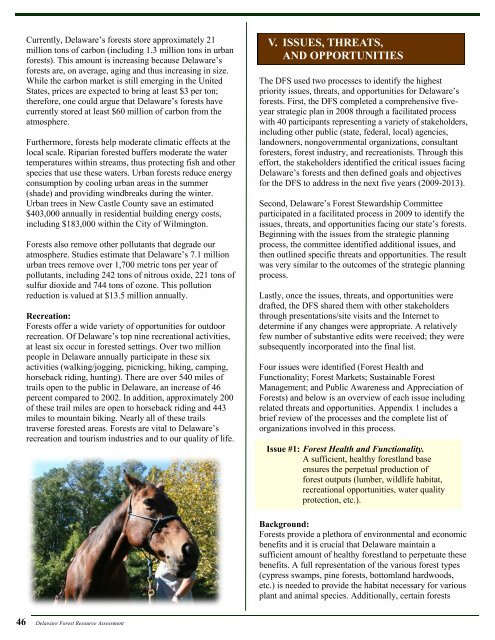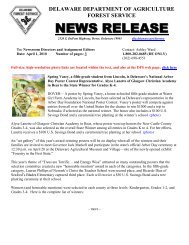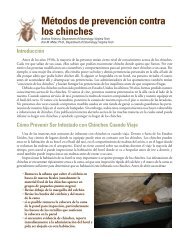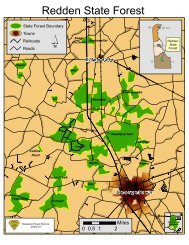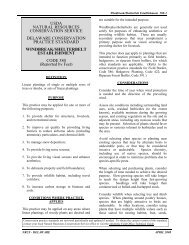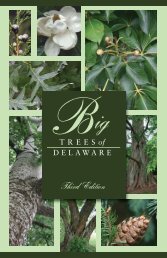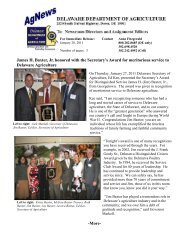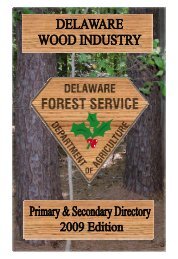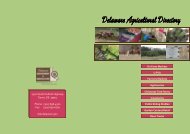DFS Resource Assessment - Delaware Department of Agriculture
DFS Resource Assessment - Delaware Department of Agriculture
DFS Resource Assessment - Delaware Department of Agriculture
You also want an ePaper? Increase the reach of your titles
YUMPU automatically turns print PDFs into web optimized ePapers that Google loves.
Currently, <strong>Delaware</strong>’s forests store approximately 21<br />
million tons <strong>of</strong> carbon (including 1.3 million tons in urban<br />
forests). This amount is increasing because <strong>Delaware</strong>’s<br />
forests are, on average, aging and thus increasing in size.<br />
While the carbon market is still emerging in the United<br />
States, prices are expected to bring at least $3 per ton;<br />
therefore, one could argue that <strong>Delaware</strong>’s forests have<br />
currently stored at least $60 million <strong>of</strong> carbon from the<br />
atmosphere.<br />
Furthermore, forests help moderate climatic effects at the<br />
local scale. Riparian forested buffers moderate the water<br />
temperatures within streams, thus protecting fish and other<br />
species that use these waters. Urban forests reduce energy<br />
consumption by cooling urban areas in the summer<br />
(shade) and providing windbreaks during the winter.<br />
Urban trees in New Castle County save an estimated<br />
$403,000 annually in residential building energy costs,<br />
including $183,000 within the City <strong>of</strong> Wilmington.<br />
Forests also remove other pollutants that degrade our<br />
atmosphere. Studies estimate that <strong>Delaware</strong>’s 7.1 million<br />
urban trees remove over 1,700 metric tons per year <strong>of</strong><br />
pollutants, including 242 tons <strong>of</strong> nitrous oxide, 221 tons <strong>of</strong><br />
sulfur dioxide and 744 tons <strong>of</strong> ozone. This pollution<br />
reduction is valued at $13.5 million annually.<br />
Recreation:<br />
Forests <strong>of</strong>fer a wide variety <strong>of</strong> opportunities for outdoor<br />
recreation. Of <strong>Delaware</strong>’s top nine recreational activities,<br />
at least six occur in forested settings. Over two million<br />
people in <strong>Delaware</strong> annually participate in these six<br />
activities (walking/jogging, picnicking, hiking, camping,<br />
horseback riding, hunting). There are over 540 miles <strong>of</strong><br />
trails open to the public in <strong>Delaware</strong>, an increase <strong>of</strong> 46<br />
percent compared to 2002. In addition, approximately 200<br />
<strong>of</strong> these trail miles are open to horseback riding and 443<br />
miles to mountain biking. Nearly all <strong>of</strong> these trails<br />
traverse forested areas. Forests are vital to <strong>Delaware</strong>’s<br />
recreation and tourism industries and to our quality <strong>of</strong> life.<br />
V. ISSUES, THREATS,<br />
AND OPPORTUNITIES<br />
The <strong>DFS</strong> used two processes to identify the highest<br />
priority issues, threats, and opportunities for <strong>Delaware</strong>’s<br />
forests. First, the <strong>DFS</strong> completed a comprehensive fiveyear<br />
strategic plan in 2008 through a facilitated process<br />
with 40 participants representing a variety <strong>of</strong> stakeholders,<br />
including other public (state, federal, local) agencies,<br />
landowners, nongovernmental organizations, consultant<br />
foresters, forest industry, and recreationists. Through this<br />
effort, the stakeholders identified the critical issues facing<br />
<strong>Delaware</strong>’s forests and then defined goals and objectives<br />
for the <strong>DFS</strong> to address in the next five years (2009-2013).<br />
Second, <strong>Delaware</strong>’s Forest Stewardship Committee<br />
participated in a facilitated process in 2009 to identify the<br />
issues, threats, and opportunities facing our state’s forests.<br />
Beginning with the issues from the strategic planning<br />
process, the committee identified additional issues, and<br />
then outlined specific threats and opportunities. The result<br />
was very similar to the outcomes <strong>of</strong> the strategic planning<br />
process.<br />
Lastly, once the issues, threats, and opportunities were<br />
drafted, the <strong>DFS</strong> shared them with other stakeholders<br />
through presentations/site visits and the Internet to<br />
determine if any changes were appropriate. A relatively<br />
few number <strong>of</strong> substantive edits were received; they were<br />
subsequently incorporated into the final list.<br />
Four issues were identified (Forest Health and<br />
Functionality; Forest Markets; Sustainable Forest<br />
Management; and Public Awareness and Appreciation <strong>of</strong><br />
Forests) and below is an overview <strong>of</strong> each issue including<br />
related threats and opportunities. Appendix 1 includes a<br />
brief review <strong>of</strong> the processes and the complete list <strong>of</strong><br />
organizations involved in this process.<br />
Issue #1: Forest Health and Functionality.<br />
A sufficient, healthy forestland base<br />
ensures the perpetual production <strong>of</strong><br />
forest outputs (lumber, wildlife habitat,<br />
recreational opportunities, water quality<br />
protection, etc.).<br />
Background:<br />
Forests provide a plethora <strong>of</strong> environmental and economic<br />
benefits and it is crucial that <strong>Delaware</strong> maintain a<br />
sufficient amount <strong>of</strong> healthy forestland to perpetuate these<br />
benefits. A full representation <strong>of</strong> the various forest types<br />
(cypress swamps, pine forests, bottomland hardwoods,<br />
etc.) is needed to provide the habitat necessary for various<br />
plant and animal species. Additionally, certain forests<br />
46 <strong>Delaware</strong> Forest <strong>Resource</strong> <strong>Assessment</strong>


